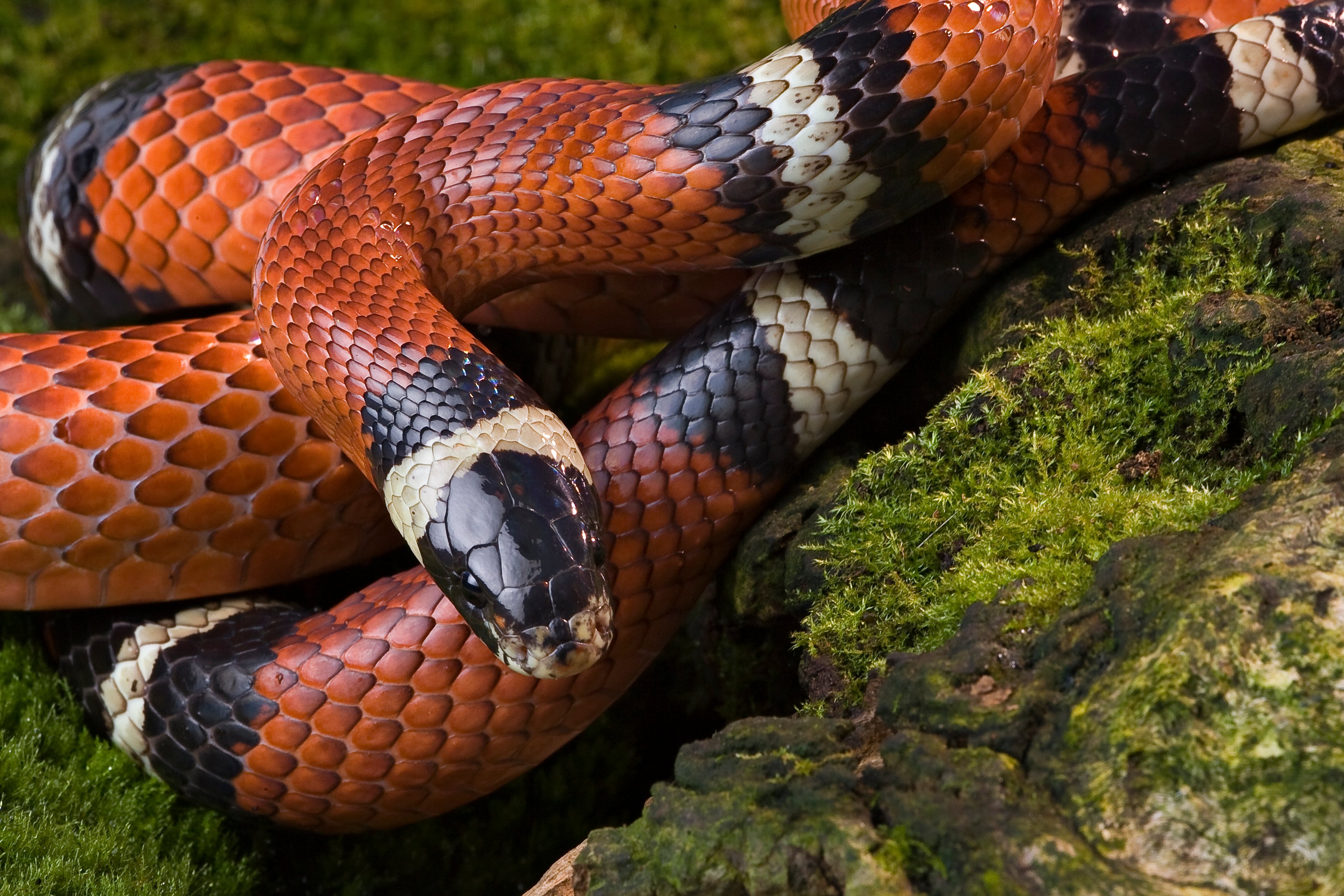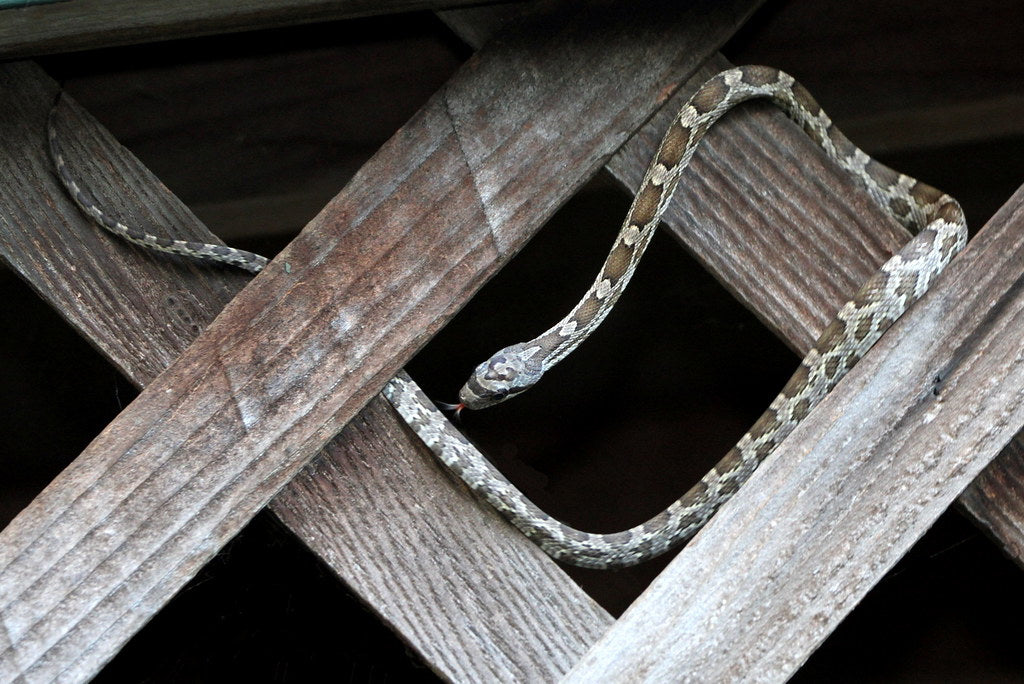Rough green snakes (Opheodrys aestivus) are small, arboreal, diurnal snakes native to the southeastern United States and northwestern Mexico. They tend to prefer wet habitats like swamps and woodlands where they can cruise the branches of bushes and small trees for prey.
Rough green snakes are typically 2-3’ long, although they can be as long as 4’ in rare cases. They have a slender body, oval-shaped head, keeled scales, and round pupils. Coloring is bright yellow-green on top with a cream or yellow underside, including the lower jaw. Faded blue-green coloring may be a sign of poor health.
Rough green snakes are shy and can be difficult to care for when wild-caught. However, when cared for properly, they can make delightful display animals capable of living 15 years or more.
Note: Rough green snakes may be very common in the US, but that is not a reason to take one from the wild. In fact, they are illegal to own in some states. If you want a pet rough green snake, check your local laws and purchase one from a breeder. Never take reptiles from the wild!
How much space do rough green snakes need?
Because rough green snakes are slender, it’s easy to think of them as smaller than they really are, keeping them in enclosures that are too small for them to stretch out fully, explore, and climb. Keep in mind that these little snakes are quite active! The minimum for appropriately keeping one adult rough green snake is 18”L x 18”W x 36”H. This is just the minimum, so using larger dimensions is beneficial and will happily be used!
Because rough green snakes are so tiny (especially when they’re babies!), it’s important to take pains to make the enclosure completely escape-proof. Sliding doors should be avoided, as this species has been known to exploit the gap between the doors. Top-opening enclosures should also be avoided. Block wire ports with hot glue or bits of moistened paper towel.
Cohabitation (keeping multiple rough green snakes in one enclosure) tends to work well with rough green snakes. A group of up to three can be kept in a 36” x 18” x 36” enclosure.
Do rough green snakes need UVB?
Unlike many other snakes, rough green snakes will quickly die without access to appropriate UVB lighting. They also benefit from bright plant grow lights in their environment to further simulate daylight. Lights should be on for 11 hours/day during winter and 13 hours/day during summer to simulate seasonal changes in day length.
The best UVB bulbs for rough green snakes are:
- Zoo Med T8 Reptisun 5.0
- Arcadia ShadeDweller kit
The UVB bulb should be housed in a high-quality reflective fixture and placed close to the heat lamp, on top of the terrarium mesh and 6-11” above the basking branch. UVB is blocked by glass and plastic, so you can’t give your snake UVB by placing its terrarium in front of an open window. Also make sure that the fixture your UVB bulb is in does not have a clear plastic bulb cover.
As a day-active species, rough green snakes are energized by having a bright 6500K LED or T5 HO fluorescent grow light as part of their environment. It’s good for any live plants you have, too!
What basking temperatures do rough green snakes need?
Like other reptiles, rough green snakes are ectotherms, which means that they need a temperature gradient in their enclosure to help them regulate their metabolism and stay healthy.
Rough green snakes should have a basking area temperature of 90°F. On the other side of the enclosure, the temperature should go down to 72°F. Surface temperatures can be measured with an infrared thermometer, but air temperatures should be measured with a digital probe thermometer. Heating should be turned off at night.
Provide heat for your rough green snake by imitating the sun with a cluster of two low-wattage, 5.5” halogen heat lamps placed on one side of the enclosure, positioned over a sturdy basking branch or warm hide. Do not use ceramic heat emitters (CHEs), red bulbs, or blue bulbs, as these are not as effective.
What humidity levels do rough green snakes need?
Rough green snakes need an average humidity between 50-75%, as measured by a digital probe hygrometers placed in the middle of the enclosure. There should also be a humid hide for your snake, lined with moistened sphagnum moss and preferably tucked among the climbing branches. Always having a humid retreat is essential!
Misting your snake’s enclosure with a sprayer first thing in the morning and again at night (if needed) will help create the right humidity levels. If you need more, moisten the substrate by mixing water into it as needed. However, perpetually wet conditions can be just as harmful as dry conditions, so it’s okay to let the enclosure dry out between mistings.
What substrate is good for rough green snakes?
Substrate covers the floor of your snake’s terrarium and helps make the enclosure more attractive, but it also helps maintain humidity. It’s ideal to use a substrate that imitates the “substrate” that the reptile naturally lives on in the wild. For rough green snakes, that means it should resemble temperate to tropical soil. It should have small particles and hold moisture well.
We recommend the following substrates for rough green snakes:
Layering clean, chemical-free leaf litter on top of the substrate can also help with humidity.
Substrate should be at least 2” deep and completely replaced every 3-4 months. Remove poop and urates daily, along with contaminated substrate.
What décor can you use in a rough green snake terrarium?
It’s terribly boring (and stressful!) for a rough green snake to be stuck in an enclosure with nothing in it except substrate, a water bowl, and a cave. It doesn’t matter how big the enclosure is if you don’t put things in it for your pet to use and interact with. Rough green snakes tend to appreciate a fairly densely planted enclosure with either live or artificial plants, which can make their terrarium a great piece of home décor!
At bare minimum, you will need a branch for your rough green snake to bask on and some live or artificial foliage for it to hide in. However, it’s best to include other items, such as:
- branches, twigs, and vines
- cork hollows
- ledges
- live or artificial plants
What do rough green snakes eat?
Unlike most other snakes, rough green snakes are primarily insectivorous, which means that they need to eat insects in order to get the nutrition that their bodies need — not rodents!
Because insects are less calorie-dense than vertebrate prey, they need to eat fairly often: juveniles should be fed daily, but fully-grown adults can be fed 2-3x/week. Offer 2-3 insects roughly the same size as your snake’s at each feeding. Avoid dumping large quantities of feeders into the enclosure, as having a lot of bugs crawling around will stress your snake.
Feeder insects for rough green snakes: dubias, discoids, crickets, black soldier flies, isopods, hornworms, silkworms, waxworms, wax moths, millipedes
Variety is essential to maintaining your rough green snake’s health!
Supplements
Because they eat insects, you will also need calcium and vitamin supplements to prevent your rough green snake from potentially developing a deficiency. We recommend Repashy Calcium Plus LoD, lightly dusted on all feeder insects.
Water
Although your snake will get most of its drinking water from daily mistings, it’s a good idea to also provide a wall-mounted water dish. Change the water daily and scrub the bowl with a reptile-safe disinfectant weekly, or whenever it becomes soiled.
Do rough green snakes like to be handled?
Few reptiles actually “like” to be held, and rough green snakes aren’t one of them. Instead of interacting with your rough green snake by holding it, try hand-feeding it instead with a pair of feeding tweezers.
If you have to grab your snake, grasp them firmly but gently, and hold them close to your body. Rough green snakes rarely bite humans.
*This care sheet contains only very basic information. Although it’s a good introduction, please do further research with high-quality sources to obtain additional information on caring for this species.
"Opheodrys aestivus aestivus (Northern Rough Greensnake)" by Andrew Hoffman is licensed under CC BY-NC-ND 2.0




Leave a comment
This site is protected by hCaptcha and the hCaptcha Privacy Policy and Terms of Service apply.